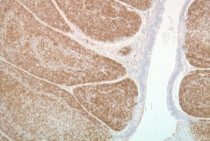ARG23986
anti-CD268 / BAFF R antibody [2C4]
anti-CD268 / BAFF R antibody [2C4] for Flow cytometry,IHC-Frozen sections,IHC-Formalin-fixed paraffin-embedded sections and Chicken,Duck,Turkey
Overview
| Product Description | Mouse Monoclonal antibody [2C4] recognizes CD268 / BAFF R |
|---|---|
| Tested Reactivity | Chk, Duck, Turkey |
| Tested Application | FACS, IHC-Fr, IHC-P |
| Host | Mouse |
| Clonality | Monoclonal |
| Clone | 2C4 |
| Isotype | IgG1 |
| Target Name | CD268 / BAFF R |
| Antigen Species | Chicken |
| Immunogen | Chicken BAFF R transfected HEK293 cells. |
| Conjugation | Un-conjugated |
| Alternate Names | CD antigen CD268; BROMIX; BAFF-R; CD268; Tumor necrosis factor receptor superfamily member 13C; BAFF receptor; BAFFR; B-cell-activating factor receptor; prolixin; CVID4; BLyS receptor 3 |
Application Instructions
| Application Suggestion |
|
||||||||
|---|---|---|---|---|---|---|---|---|---|
| Application Note | FACS: Use 10 µl of the suggested working dilution to label 10^6 cells in 100 µl. * The dilutions indicate recommended starting dilutions and the optimal dilutions or concentrations should be determined by the scientist. |
Properties
| Form | Liquid |
|---|---|
| Purification | Purification with Protein G. |
| Buffer | PBS and 0.01% Sodium azide. |
| Preservative | 0.01% Sodium azide |
| Concentration | 1 mg/ml |
| Storage Instruction | For continuous use, store undiluted antibody at 2-8°C for up to a week. For long-term storage, aliquot and store at -20°C or below. Storage in frost free freezers is not recommended. Avoid repeated freeze/thaw cycles. Suggest spin the vial prior to opening. The antibody solution should be gently mixed before use. |
| Note | For laboratory research only, not for drug, diagnostic or other use. |
Bioinformation
| Gene Symbol | TNFRSF13C |
|---|---|
| Gene Full Name | tumor necrosis factor receptor superfamily, member 13C |
| Background | B cell-activating factor (BAFF) enhances B-cell survival in vitro and is a regulator of the peripheral B-cell population. Overexpression of Baff in mice results in mature B-cell hyperplasia and symptoms of systemic lupus erythematosus (SLE). Also, some SLE patients have increased levels of BAFF in serum. Therefore, it has been proposed that abnormally high levels of BAFF may contribute to the pathogenesis of autoimmune diseases by enhancing the survival of autoreactive B cells. The protein encoded by this gene is a receptor for BAFF and is a type III transmembrane protein containing a single extracellular cysteine-rich domain. It is thought that this receptor is the principal receptor required for BAFF-mediated mature B-cell survival. [provided by RefSeq, Jul 2008] |
| Function | B-cell receptor specific for TNFSF13B/TALL1/BAFF/BLyS. Promotes the survival of mature B-cells and the B-cell response. [UniProt] |
| Cellular Localization | Membrane; Single-pass type III membrane protein. [UniProt] |
| Calculated MW | 19 kDa |
Images (2) Click the Picture to Zoom In
-
ARG23986 anti-CD268 / BAFF R antibody [2C4] IHC-P image
Immunohistochemistry: Paraffin-embedded section of bursal tissue were stained with ARG23986 anti-CD268 / BAFF R antibody [2C4] at 2.5 µg/ml dilution.
-
ARG23986 anti-CD268 / BAFF R antibody [2C4] FACS image
Flow Cytometry: Peripheral blood lymphocytes were separated by density centrifugation and first stained with ARG23986 anti-CD268 / BAFF R antibody [2C4] and then with FITC-conjugated Goat anti Mouse IgG1 secondary antibody, finally blocked with 10% normal Mouse serum and followed by stained with anti-Bu1a + Bu1b antibody [AV20] (APC).







